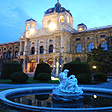THE EMPEROR TOMB - KAISER CRYPT VIENNA
Habsburg Burial Monuments to a Dead Monarchy
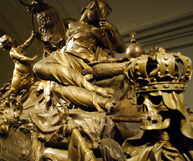 Vienna is a vibrant city. Music plays every evening, cafes filled with
lively discussions and art parties in the museum district. Vienna is
the Imperial City. The historic capital of the Habsburg Dynasty, the
family who ruled much of the European world, and lands in the new world
as well. Rulers of the Holy Roman Empire and the Austro-Hungarian Empire
in various shapes and forms from the Baltic to northern Italy, Austria,
portions of Germany, even Mexico for a time, with marriage alliances
to the monarchy of France. They ruled from Vienna and are buried in Vienna.
Vienna is a vibrant city. Music plays every evening, cafes filled with
lively discussions and art parties in the museum district. Vienna is
the Imperial City. The historic capital of the Habsburg Dynasty, the
family who ruled much of the European world, and lands in the new world
as well. Rulers of the Holy Roman Empire and the Austro-Hungarian Empire
in various shapes and forms from the Baltic to northern Italy, Austria,
portions of Germany, even Mexico for a time, with marriage alliances
to the monarchy of France. They ruled from Vienna and are buried in Vienna.
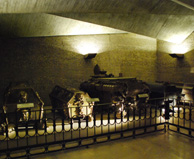 The Emperor
Tomb in the nether chambers below the Capuchin Church of Vienna, where
monks
in dark robes still serve in their quiet devotion,
the sarcophagi of the Habsburg kings, queens, relatives and descendents
crowd the stonework confines of a collection of rooms and chambers. Beginning
with relatively simple coffins from the beginning of the family’s
power in Austria in the 1600s and each flowing more grand and ornate
in sculpted bronze, elegant to just purely ostentatious representation
of wealth an position in death, they are fascinating and just a but creepy.
The Emperor
Tomb in the nether chambers below the Capuchin Church of Vienna, where
monks
in dark robes still serve in their quiet devotion,
the sarcophagi of the Habsburg kings, queens, relatives and descendents
crowd the stonework confines of a collection of rooms and chambers. Beginning
with relatively simple coffins from the beginning of the family’s
power in Austria in the 1600s and each flowing more grand and ornate
in sculpted bronze, elegant to just purely ostentatious representation
of wealth an position in death, they are fascinating and just a but creepy.
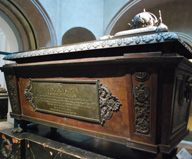 In German
called the Kaisergruft or sometimes the Kapuzinergruft for its place
below the
church built in the city’s then new market
square where flour was traded began its tradition as the imperial burial
place in 1633. Empress Anna the wife of Emperor Matthias wanted his wife
the Empress Anna to be interred in a permanent tomb within the old city
walls of Vienna, with the emperor following beloved into the crypt. Today
146 are buried in the crypt, including 12 emperors, 19 empresses and
queens, the rest family members. The Habsburg empire died with World
War I, but the family is still around listing a long line of grand dukes,
duchesses and some continue to find a resting place in the emperors crypt.
In German
called the Kaisergruft or sometimes the Kapuzinergruft for its place
below the
church built in the city’s then new market
square where flour was traded began its tradition as the imperial burial
place in 1633. Empress Anna the wife of Emperor Matthias wanted his wife
the Empress Anna to be interred in a permanent tomb within the old city
walls of Vienna, with the emperor following beloved into the crypt. Today
146 are buried in the crypt, including 12 emperors, 19 empresses and
queens, the rest family members. The Habsburg empire died with World
War I, but the family is still around listing a long line of grand dukes,
duchesses and some continue to find a resting place in the emperors crypt.
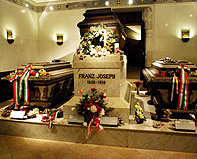 The
ornate bronze baroque sculpture decorations depict symbols of life
and death,
reminders
to royalty of the equality of mortality, while the
ever increasing grandeur of the tombs shows the inequality of power a
position. The grandest of the tombs is of the Empress Maria Theresa,
with its morbid beautiful splendor in its own high chamber, enlarged
in 1753 under the sacristy-garden. The size is due to the space for joint
tenancy of Maria Theresa and her husband Emperor Franz Stephen, buried
together and forever looking into each other's eyes (see Schonbrunn
Palace).
The Maria Theresa sarcophagus was the last of the ornate Baroque
coffins, with
the inception “emperor
period” thinking, the tombs became simpler. While many of the names
are relegated to the corners of history, the adoration of former subjects
and admirers is still alive in the Emperor’s Crypt, the
tombs of Franz Joseph the last
The
ornate bronze baroque sculpture decorations depict symbols of life
and death,
reminders
to royalty of the equality of mortality, while the
ever increasing grandeur of the tombs shows the inequality of power a
position. The grandest of the tombs is of the Empress Maria Theresa,
with its morbid beautiful splendor in its own high chamber, enlarged
in 1753 under the sacristy-garden. The size is due to the space for joint
tenancy of Maria Theresa and her husband Emperor Franz Stephen, buried
together and forever looking into each other's eyes (see Schonbrunn
Palace).
The Maria Theresa sarcophagus was the last of the ornate Baroque
coffins, with
the inception “emperor
period” thinking, the tombs became simpler. While many of the names
are relegated to the corners of history, the adoration of former subjects
and admirers is still alive in the Emperor’s Crypt, the
tombs of Franz Joseph the last 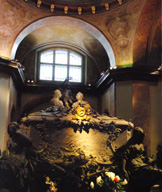 great Austria-Hungarian emperor, and
Maximilian, Mexico’s last feudal ruler still have fresh flowers and offerings.
Emperor Franz II has four wives buried around him, one of them, Elizabeth
Wilhemene, daughter of "Fat" King Freidrich II of Wurttemburg
(see Palace
Ludwigsburg Baroque to Empire). Napoleon's second wife,
the Empress Marie Louise (see Chateau
Fontainbleu) is buried here while
Marie Antoinette, who lost her head in a revolution is not (she’s
buried in Paris at St. Denis), and Zita of the Bourbons of Parma (see Palace
Colorno Parma). As to the Habsburg who through no real
fault of his own was the catalyst for the end of the empire, Archduke
Franz
Ferdinand
whose assassination
by a Serbian -Croatian anarchist started a domino effect to begin WWI
is not in the crypt, though a plaque explains why he was deemed unfit
to reside among his family. Not for his part in the fall of empire,
but because he had the audacity to marry – for love. Disapproved of
by his father, he and his wife Sophie, shot with him in a car in a
Sarajevo alley, are buried in Austria’s Artsetten castle.
great Austria-Hungarian emperor, and
Maximilian, Mexico’s last feudal ruler still have fresh flowers and offerings.
Emperor Franz II has four wives buried around him, one of them, Elizabeth
Wilhemene, daughter of "Fat" King Freidrich II of Wurttemburg
(see Palace
Ludwigsburg Baroque to Empire). Napoleon's second wife,
the Empress Marie Louise (see Chateau
Fontainbleu) is buried here while
Marie Antoinette, who lost her head in a revolution is not (she’s
buried in Paris at St. Denis), and Zita of the Bourbons of Parma (see Palace
Colorno Parma). As to the Habsburg who through no real
fault of his own was the catalyst for the end of the empire, Archduke
Franz
Ferdinand
whose assassination
by a Serbian -Croatian anarchist started a domino effect to begin WWI
is not in the crypt, though a plaque explains why he was deemed unfit
to reside among his family. Not for his part in the fall of empire,
but because he had the audacity to marry – for love. Disapproved of
by his father, he and his wife Sophie, shot with him in a car in a
Sarajevo alley, are buried in Austria’s Artsetten castle.
Inside the outer casings the lesser blue bloods rest in wood coffins lined with velvet and embellished with medallions. The coffins of the ruling sovereigns and their spouses are of black velvet and gold, archdukes red velvet and silver. There are two keys to the sarcophaguses, one kept by the Capuchin friars and the other by the treasury minister. And though the bodies are here, in a tradition of royal quirkiness, their hearts are not. Like pharaohs before the innards were removed for embalming and put in silver or copper urns. The hearts of several Habsburgs are kept in a separate Hearts Crypt behind a locked door in the Augustiner Church of Vienna.
Visiting the Vienna Emperor Tomb Crypt
Located behind the Hofburg Palace complex in the center of old Vienna, a steep stairway into the Emperor Crypt bears the inscription “Silence” for reverence for the resting, but also perhaps lest you re-awaken hereditary monarchy. Entrance to the Kaisergruft is 5 Euro for adults, 11 Euro for a family ticket. It’s open 10 to 6 pm all year except for the 1st and 2nd of November. © Bargain Travel Europe
Find best hotel and travel deals in Vienna on TripAdvisor
Web Info
KaiserGruft
These articles are copyrighted and the sole property of Bargain Travel Europe and WLPV, LLC. and may not be copied or reprinted without permission.
SEE ALSO:
IMPERIAL TREASURE CHAMBER IN VIENNA
IMPERIAL COACH MUSEUM SCHÖNBRUNN
HABSBURG ARMS & ARMOR COLLECTION
INNSBRUCK'S
COURT CHURCH - HOFKIRCHE TOMB
HOFBURG IMPERIAL
PALACE - INNSBRUCK
DEMEL CAFE & CONFECTIONARY VIENNA
TREASURES OF ST STEPHENS CATHEDRAL

